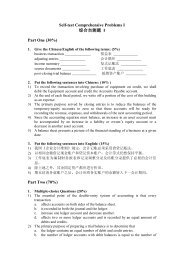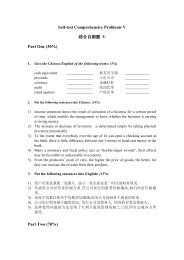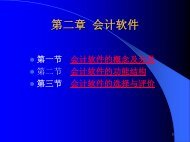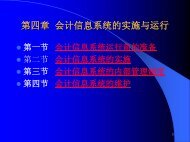Vodafone Group Plc Annual Report for the year ended 31 March 2012
Vodafone Group Plc Annual Report for the year ended 31 March 2012
Vodafone Group Plc Annual Report for the year ended 31 March 2012
You also want an ePaper? Increase the reach of your titles
YUMPU automatically turns print PDFs into web optimized ePapers that Google loves.
<strong>Vodafone</strong> <strong>Group</strong> <strong>Plc</strong><br />
<strong>Annual</strong> <strong>Report</strong> <strong>2012</strong><br />
105<br />
Fair value hedges<br />
The <strong>Group</strong>’s policy is to use derivative instruments (primarily interest rate swaps) to convert a proportion of its fixed rate debt to floating rates in<br />
order to hedge <strong>the</strong> interest rate risk arising, principally, from capital market borrowings. The <strong>Group</strong> designates <strong>the</strong>se as fair value hedges of interest<br />
rate risk with changes in fair value of <strong>the</strong> hedging instrument recognised in <strong>the</strong> income statement <strong>for</strong> <strong>the</strong> period toge<strong>the</strong>r with <strong>the</strong> changes in <strong>the</strong><br />
fair value of <strong>the</strong> hedged item due to <strong>the</strong> hedged risk, to <strong>the</strong> extent <strong>the</strong> hedge is effective. The ineffective portion is recognised immediately in <strong>the</strong><br />
income statement.<br />
Cash flow hedges<br />
Cash flow hedging is used by <strong>the</strong> <strong>Group</strong> to hedge certain exposures to variability in future cash flows. The effective portion of changes in <strong>the</strong> fair<br />
value of derivatives that are designated and qualify as cash flow hedges is recognised in o<strong>the</strong>r comprehensive income; gains or losses relating to<br />
any ineffective portion are recognised immediately in <strong>the</strong> income statement.<br />
When <strong>the</strong> hedged item is recognised in <strong>the</strong> income statement amounts previously recognised in o<strong>the</strong>r comprehensive income and accumulated<br />
in equity <strong>for</strong> <strong>the</strong> hedging instrument are reclassified to <strong>the</strong> income statement and recognised in <strong>the</strong> same line. However, when <strong>the</strong> hedged<br />
<strong>for</strong>ecast transaction results in <strong>the</strong> recognition of a non-financial asset or a non-financial liability, <strong>the</strong> gains and losses previously recognised in<br />
o<strong>the</strong>r comprehensive income and accumulated in equity are transferred from equity and included in <strong>the</strong> initial measurement of <strong>the</strong> cost of <strong>the</strong><br />
non-financial asset or non-financial liability.<br />
When hedge accounting is discontinued any gain or loss recognised in o<strong>the</strong>r comprehensive income at that time remains in equity and is<br />
recognised in <strong>the</strong> income statement when <strong>the</strong> hedged transaction is ultimately recognised in <strong>the</strong> income statement. If a <strong>for</strong>ecast transaction is no<br />
longer expected to occur, <strong>the</strong> gain or loss accumulated in equity is recognised immediately in <strong>the</strong> income statement.<br />
Net investment hedges<br />
Exchange differences arising from <strong>the</strong> translation of <strong>the</strong> net investment in <strong>for</strong>eign operations are recognised directly in equity. Gains and losses<br />
on those hedging instruments (which include bonds, commercial paper and <strong>for</strong>eign exchange contracts) designated as hedges of <strong>the</strong> net<br />
investments in <strong>for</strong>eign operations are recognised in equity to <strong>the</strong> extent that <strong>the</strong> hedging relationship is effective. These amounts are included in<br />
exchange differences on translation of <strong>for</strong>eign operations as stated in <strong>the</strong> statement of comprehensive income. Gains and losses relating to hedge<br />
ineffectiveness are recognised immediately in <strong>the</strong> income statement <strong>for</strong> <strong>the</strong> period. Gains and losses accumulated in <strong>the</strong> translation reserve are<br />
included in <strong>the</strong> income statement when <strong>the</strong> <strong>for</strong>eign operation is disposed of.<br />
Put option arrangements<br />
The potential cash payments related to put options issued by <strong>the</strong> <strong>Group</strong> over <strong>the</strong> equity of subsidiary companies are accounted <strong>for</strong> as financial<br />
liabilities when such options may only be settled o<strong>the</strong>r than by exchange of a fixed amount of cash or ano<strong>the</strong>r financial asset <strong>for</strong> a fixed number of<br />
shares in <strong>the</strong> subsidiary.<br />
The amount that may become payable under <strong>the</strong> option on exercise is initially recognised at fair value within borrowings with a corresponding<br />
charge directly to equity. The charge to equity is recognised separately as written put options over non-controlling interests, adjacent to noncontrolling<br />
interests in <strong>the</strong> net assets of consolidated subsidiaries. The <strong>Group</strong> recognises <strong>the</strong> cost of writing such put options, determined as <strong>the</strong><br />
excess of <strong>the</strong> fair value of <strong>the</strong> option over any consideration received, as a financing cost.<br />
Such options are subsequently measured at amortised cost, using <strong>the</strong> effective interest rate method, in order to accrete <strong>the</strong> liability up to <strong>the</strong><br />
amount payable under <strong>the</strong> option at <strong>the</strong> date at which it first becomes exercisable. The charge arising is recorded as a financing cost. In <strong>the</strong> event<br />
that <strong>the</strong> option expires unexercised, <strong>the</strong> liability is derecognised with a corresponding adjustment to equity.<br />
Provisions<br />
Provisions are recognised when <strong>the</strong> <strong>Group</strong> has a present obligation (legal or constructive) as a result of a past event, it is probable that <strong>the</strong> <strong>Group</strong><br />
will be required to settle that obligation and a reliable estimate can be made of <strong>the</strong> amount of <strong>the</strong> obligation. Provisions are measured at <strong>the</strong><br />
directors’ best estimate of <strong>the</strong> expenditure required to settle <strong>the</strong> obligation at <strong>the</strong> reporting date and are discounted to present value where <strong>the</strong><br />
effect is material.<br />
Share-based payments<br />
The <strong>Group</strong> issues equity-settled share-based payments to certain employees. Equity-settled share-based payments are measured at fair value<br />
(excluding <strong>the</strong> effect of non-market-based vesting conditions) at <strong>the</strong> date of grant. The fair value determined at <strong>the</strong> grant date of <strong>the</strong> equity-settled<br />
share-based payments is expensed on a straight-line basis over <strong>the</strong> vesting period, based on <strong>the</strong> <strong>Group</strong>’s estimate of <strong>the</strong> shares that will eventually<br />
vest and adjusted <strong>for</strong> <strong>the</strong> effect of non-market-based vesting conditions.<br />
Fair value is measured using a binomial pricing model, being a lattice-based option valuation model, which is calibrated using a Black-Scholes<br />
framework. The expected life used in <strong>the</strong> model has been adjusted, based on management’s best estimate, <strong>for</strong> <strong>the</strong> effects of non-transferability,<br />
exercise restrictions and behavioural considerations.<br />
The <strong>Group</strong> uses historical data to estimate option exercise and employee termination within <strong>the</strong> valuation model; separate groups of employees<br />
that have similar historical exercise behaviour are considered separately <strong>for</strong> valuation purposes. The expected life of options granted is derived from<br />
<strong>the</strong> output of <strong>the</strong> option valuation model and represents <strong>the</strong> period of time that options are expected to be outstanding. Expected volatilities are<br />
based on implied volatilities as determined by a simple average of no less than three international banks, excluding <strong>the</strong> highest and lowest numbers.<br />
The risk free rates <strong>for</strong> periods within <strong>the</strong> contractual life of <strong>the</strong> option are based on <strong>the</strong> UK gilt yield curve in effect at <strong>the</strong> time of grant.<br />
Some share awards have an attached market condition, based on total shareholder return (“TSR”), which is taken into account when calculating <strong>the</strong><br />
fair value of <strong>the</strong> share awards. The valuation <strong>for</strong> <strong>the</strong> TSR is based on <strong>Vodafone</strong>’s ranking within <strong>the</strong> same group of companies, where possible, over<br />
<strong>the</strong> past five <strong>year</strong>s. The volatility of <strong>the</strong> ranking over a three <strong>year</strong> period is used to determine <strong>the</strong> probable weighted percentage number of shares<br />
that could be expected to vest and hence affect fair value.<br />
The fair value of awards of non-vested shares is equal to <strong>the</strong> closing price of <strong>the</strong> <strong>Vodafone</strong>’s shares on <strong>the</strong> date of grant, adjusted <strong>for</strong> <strong>the</strong> present value<br />
of future dividend entitlements where appropriate.<br />
Business review Per<strong>for</strong>mance Governance Financials Additional in<strong>for</strong>mation






